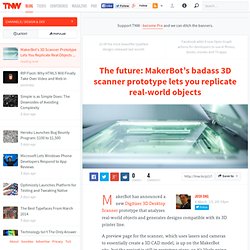

MakerBot Unveils Digitizer Desktop 3D Scanner. MakerBot opened this year's SXSW in Austin by unveiling the MakerBot Digitizer Desktop 3D Scanner, a device intended to facilitate 3D printing on the company's flagship devices.

"It's a natural progression for us to create a product that makes 3D printing even easier," Bre Pettis, CEO of MakerBot, said in a statement. "With the MakerBot Digitizer Desktop 3D Scanner, now everyone will be able to scan a physical item, digitize it, and print it in 3D – with little or no design experience.
" At this point, the Digitizer 3D scanner is still a prototype, and MakerBot said it will spend time testing, scanning, and 3D printing the items scanned with it. "The MakerBot Digitizer Desktop 3D Scanner is an innovative new way to take a physical object, scan it, and create a digital file – without any design, CAD software or 3D modeling experience at all – and then print the item again and again on a MakerBot Replicator 2 or MakerBot Replicator 2X Experimental 3D Printer," Pettis said. The future: MakerBot’s badass 3D scanner prototype lets you replicate real-world objects. MakerBot has announced a new Digitizer 3D Desktop Scanner prototype that analyzes real-world objects and generates designs compatible with its 3D printer line.

A preview page for the scanner, which uses lasers and cameras to essentially create a 3D CAD model, is up on the MakerBot site, but the project is still in prototype stage, so it’s likely going to be a while before this thing is released. “We are super excited to be able to announce at SXSW Interactive that we are developing the MakerBot Digitizer Desktop 3D Scanner,” MakerBot CEO Bre Pettis said in a statement. “It’s a natural progression for us to create a product that makes 3D printing even easier. With the MakerBot Digitizer, now everyone will be able to scan a physical item, digitize it, and print it in 3D – with little or no design experience.” “If something gets broken, you can print it again,” he said. The scanner is somewhat similar in function to the 3D photo booth that MakerBot showed off last year. Samsung Galaxy S4: everything you need to know. LG sticks it to Samsung with Times Square billboard. Manchester Graphene (The University of Manchester)
Berkeley creates the first graphene earphones, and (unsurprisingly) they’re awesome. Researchers at the University of California, Berkeley have created the first ever graphene audio speaker: an earphone.

In its raw state, without any kind of optimization, the researchers show that graphene’s superior physical and electrical properties allow for an earphone with frequency response comparable to or better than a pair of commercial Sennheiser earphones. A loudspeaker (or earphone or headphone) works by vibrating a (usually) paper diaphragm (aka a cone), creating pressure waves in the air around you. Depending on the frequency of these waves, different sounds are created. Human ears, depending on their age, can usually hear frequencies between 20Hz (very low pitch) and 20KHz (very high). Generally, the quality of a speaker is defined by how flat its frequency response is — in other words, whether it produces sounds equally well, no matter where they fall on the 20Hz to 20KHz scale.
Graphene earphone frequency response (top), vs. Graphene - News & Rumors. Graphene Articles on Engadget. Black Label Neo Geo custom wood mod ups the ante on collector excess.